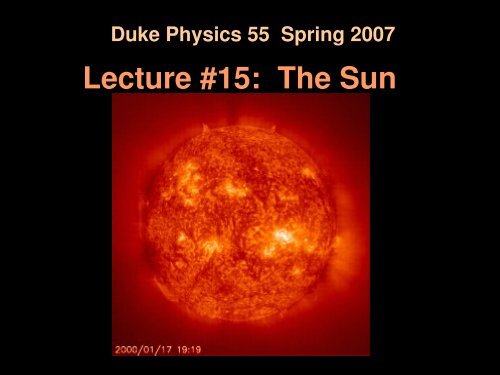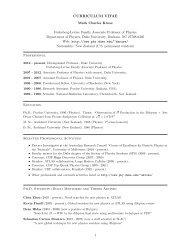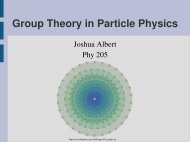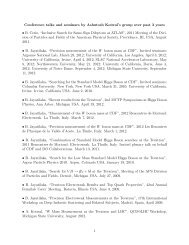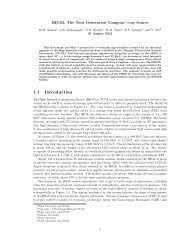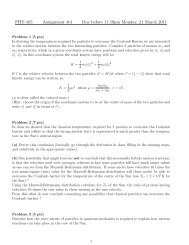Gravitational Equilibrium How does the Sun remain ... - Duke Physics
Gravitational Equilibrium How does the Sun remain ... - Duke Physics
Gravitational Equilibrium How does the Sun remain ... - Duke Physics
You also want an ePaper? Increase the reach of your titles
YUMPU automatically turns print PDFs into web optimized ePapers that Google loves.
<strong>Duke</strong> <strong>Physics</strong> 55 Spring 2007<br />
Lecture #15: The <strong>Sun</strong>
ADMINISTRATIVE STUFF<br />
Quiz 3<br />
Homework #6 due<br />
Homework #7 available
OUTLINE<br />
BDSV Chapter 14.1, 14.2<br />
Some properties of <strong>the</strong> <strong>Sun</strong><br />
What's inside <strong>the</strong> <strong>Sun</strong>?<br />
<strong>How</strong> <strong>does</strong> <strong>the</strong> <strong>Sun</strong> <strong>remain</strong> stable?<br />
<strong>How</strong> <strong>does</strong> <strong>the</strong> <strong>Sun</strong> shine?<br />
<strong>How</strong> do we know this?
LUMINOSITY: power (energy/time) output in<br />
electromagnetic radiation<br />
Solar luminosity<br />
is 3.8 x 10 26 Watts!<br />
1 second's worth of energy would supply all human<br />
needs for half a million years!
What's inside <strong>the</strong> <strong>Sun</strong>?
Anatomy of <strong>the</strong> <strong>Sun</strong>: moving outwards
Deepest Layers<br />
Core:<br />
where energy<br />
is generated<br />
Radiation zone:<br />
radiation carries<br />
energy outward<br />
Convection zone:<br />
churning gas<br />
carries energy<br />
outward<br />
p
Intermediate Layers<br />
Chromosphere:<br />
10,000 K,<br />
emits UV<br />
Photosphere:<br />
6,000 K, what appears<br />
as <strong>the</strong> 'surface' from p Earth
Outer Layers<br />
Solar wind:<br />
particles<br />
expelled<br />
Corona:<br />
1 million K,<br />
emits xrays<br />
p
<strong>How</strong> <strong>does</strong> <strong>the</strong> <strong>Sun</strong> <strong>remain</strong> stable?<br />
<strong>Gravitational</strong> <strong>Equilibrium</strong><br />
Weight of overlying material is supported by<br />
underlying pressure⇒ higher pressure in deeper layers
<strong>How</strong> <strong>does</strong> <strong>the</strong> <strong>Sun</strong> shine?<br />
Many ancients thought it<br />
was literally on fire<br />
1800's: chemical burning?<br />
gravitational contraction?<br />
(As <strong>the</strong> <strong>Sun</strong> shrinks, gravitational<br />
potential energy is converted into<br />
radiative energy)<br />
But, nei<strong>the</strong>r of <strong>the</strong>se provide enough energy...<br />
<strong>Sun</strong> would last only a short time
The answer: mass is converted<br />
to radiative energy!<br />
E=mc 2
<strong>How</strong> <strong>does</strong> it actually happen?<br />
Nuclear fusion<br />
nuclei fuse to make final nucleus with<br />
mass less than sum of initial masses<br />
mass difference released in form of radiation<br />
The <strong>Sun</strong> loses 4 billion kg/second!
This can only happen at very high temperature<br />
Nuclei repel each o<strong>the</strong>r unless <strong>the</strong>y get very close toge<strong>the</strong>r<br />
At very short<br />
distances,<br />
<strong>the</strong> nuclear<br />
strong force<br />
kicks in,<br />
and sticks<br />
protons toge<strong>the</strong>r<br />
In order to get very close, <strong>the</strong>y have to be going very fast;<br />
it's hot enough only in <strong>the</strong> core of <strong>the</strong> <strong>Sun</strong>
Hydrogen fuses into helium via <strong>the</strong><br />
protonproton chain, via several steps<br />
Overall: 4 protons (H) in, 1 He + 2 gamma rays<br />
+ 2 positrons + 2 neutrinos out<br />
(more steps later, but this is <strong>the</strong> main one)
The <strong>Sun</strong> is a Mass of Incandescent Gas<br />
(and plasma...)
Solar Thermostat: rate of fusion is highly sensitive<br />
to temperature, thanks to gravitational equilibrium
PRS Question<br />
If <strong>the</strong> electrical charge on each proton were<br />
suddenly magically to become greater, <strong>the</strong>n:<br />
a. The core of <strong>the</strong> <strong>Sun</strong> would become larger and hotter.<br />
b. The core of <strong>the</strong> <strong>Sun</strong> would become larger and cooler.<br />
c. The core of <strong>the</strong> <strong>Sun</strong> would become smaller and<br />
hotter.<br />
d. The core of <strong>the</strong> <strong>Sun</strong> would become smaller and<br />
cooler.<br />
e. Not enough information to answer.
If <strong>the</strong> electrical charge on each proton were<br />
suddenly magically to become greater, <strong>the</strong>n:<br />
a. The core of <strong>the</strong> <strong>Sun</strong> would become larger and hotter.<br />
b. The core of <strong>the</strong> <strong>Sun</strong> would become larger and cooler.<br />
c. The core of <strong>the</strong> <strong>Sun</strong> would become smaller and<br />
hotter.<br />
d. The core of <strong>the</strong> <strong>Sun</strong> would become smaller and<br />
cooler.<br />
e. Not enough information to answer.<br />
More charge requires higher temperature for fusion.<br />
Fusion at current temperature would slow down or stop;<br />
<strong>the</strong> core would contract and heat up gravitationally<br />
... whe<strong>the</strong>r fusion would restart depends on how<br />
much higher temperature is necessary!
The gamma rays slowly work <strong>the</strong>ir<br />
way out from <strong>the</strong> core to <strong>the</strong> surface<br />
exchanging energy with <strong>the</strong> solar matter<br />
(losing energy per photon ⇒ going from gamma<br />
to mostly visible wavelengths)<br />
RADIATIVE DIFFUSION: takes about 1 million<br />
years for energy to reach <strong>the</strong> surface!
What evidence do we have for this<br />
mechanism of energy generation?<br />
Ma<strong>the</strong>matical models incorporating known<br />
physics (gravity, pressure, temperature):<br />
<strong>the</strong>se make predictions that<br />
we can test against observations
Helioseismology (sun quakes)<br />
Measure<br />
movement<br />
of <strong>the</strong><br />
<strong>Sun</strong>'s<br />
surface<br />
using<br />
Doppler<br />
shift<br />
Pattern depends on temperature, density, etc:<br />
test solar models!
Ano<strong>the</strong>r way of testing <strong>the</strong> picture:<br />
NEUTRINOS: 'ghostly' particles that have<br />
very tiny mass and hardly interact with<br />
anything (only via <strong>the</strong> weak interaction)<br />
2 neutrinos are produced for each fusion reaction<br />
(a million from <strong>the</strong> <strong>Sun</strong> through your hand each second!)
Neutrinos can be detected in giant underground detectors<br />
Giant: because neutrino interactions are so rare<br />
Underground: to shield out cosmic rays<br />
My experiment in Japan: SuperKamiokande<br />
50 ktons of ultrapure water 1 km underground
Inside SuperK, filling with water
Image of <strong>the</strong> <strong>Sun</strong> in neutrinos from SuperK
Several experiments now see solar neutrinos; number<br />
is now consistent with expected from nuclear fusion<br />
Homestake mine,<br />
HUSA<br />
(cleaning fluid)<br />
SuperK, Japan<br />
(water)<br />
SNO, Canada<br />
(heavy water)
Cosmic Gall, by John Updike<br />
Neutrinos, <strong>the</strong>y are very small.<br />
They have no charge and have no mass<br />
And do not interact at all.<br />
The earth is just a silly ball<br />
To <strong>the</strong>m, through which <strong>the</strong>y simply pass,<br />
Like dustmaids through a drafty hall<br />
Or photons through a sheet of glass.<br />
They snub <strong>the</strong> most exquisite gas,<br />
Ignore <strong>the</strong> most substantial wall,<br />
Cold-shoulder steel and sounding brass,<br />
Insult <strong>the</strong> stallion in his stall,<br />
And scorning barriers of class,<br />
Infiltrate you and me! Like tall<br />
And painless guillotines, <strong>the</strong>y fall<br />
Down through our heads into <strong>the</strong> grass.<br />
At night, <strong>the</strong>y enter at Nepal<br />
And pierce <strong>the</strong> lover and his lass<br />
From underneath <strong>the</strong> bed - you call<br />
It wonderful; I call it crass.
WUN2K<br />
<strong>Sun</strong> is stable by<br />
gravitational<br />
equilibrium
WUN2K<br />
The <strong>Sun</strong> produces energy by nuclear fusion,<br />
which requires very hot temperatures in <strong>the</strong> core<br />
We know this from<br />
ma<strong>the</strong>matical models,<br />
tested by helioseismology,<br />
and neutrino detection
WUN2K<br />
'Solar <strong>the</strong>rmostat' maintains equilibrium
Minute Questionnaire<br />
Please take a minute to fill it out.<br />
I will try to answer<br />
as many (wellposed) questions<br />
on <strong>the</strong> web as I can<br />
Please use this to give me feedback


